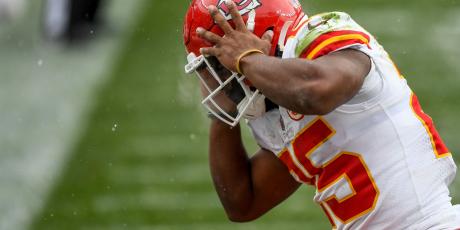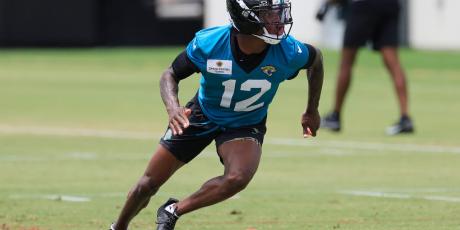Should You Be Drafting More Wide Receivers in the First Round?

As I was pulling together data for the LeVeon Bell article earlier this month, I compiled some actual, year-end production numbers (in PPR leagues) for the top five running backs drafted in each of the last 15 years. The idea was to find out just how dependable the top running backs are on average. The results were interesting.
| Year | 1 | 2 | 3 | 4 | 5 |
|---|---|---|---|---|---|
| 2014 | 12 | 7 | 127 | 3 | 6 |
| 2013 | 10 | 56 | 47 | 1 | 27 |
| 2012 | 3 | 4 | 16 | 12 | 25 |
| 2011 | 15 | 3 | 1 | 102 | 9 |
| 2010 | 6 | 5 | 7 | 13 | 16 |
| 2009 | 2 | 4 | 12 | 34 | 24 |
| 2008 | 6 | 9 | 8 | 39 | 15 |
| 2007 | 2 | 15 | 36 | 7 | 4 |
| 2006 | 1 | 3 | 33 | 6 | 2 |
| 2005 | 2 | 1 | 5 | 31 | 55 |
| 2004 | 18 | 2 | 11 | 17 | 9 |
| 2003 | 2 | 9 | 6 | 1 | 16 |
| 2002 | 10 | 11 | 6 | 3 | 1 |
| 2001 | 34 | 1 | 113 | 20 | 13 |
| 2000 | 2 | 1 | 3 | 12 | 72 |
| Average | 8.3 | 8.7 | 28.7 | 20.1 | 19.6 |
| Top 6 | 60% | 60% | 33% | 33% | 27% |
| Top 12 | 80% | 87% | 60% | 53% | 40% |
The results indicate that the top two running backs drafted yield top 6 (elite RB1) numbers 60 percent of the time and top 12 numbers (RB1 numbers) 80-87 percent of the time.
As we proceed through the draft, the numbers decline from there. Running backs drafted in the #3-#5 range yield elite RB1 numbers 31 percent of the time. They produce RB1 numbers just 51 percent of the time.
I relayed some of these numbers on Twitter, and a few followers asked if I had the same numbers for the receiver position. I didn’t at that point, but now I do.
| Year | 1 | 2 | 3 | 4 | 5 |
|---|---|---|---|---|---|
| 2014 | 16 | 2 | 4 | 24 | 6 |
| 2013 | 5 | 7 | 4 | 6 | 63 |
| 2012 | 1 | 33 | 11 | 7 | 6 |
| 2011 | 77 | 1 | 5 | 6 | 12 |
| 2010 | 7 | 74 | 3 | 12 | 6 |
| 2009 | 5 | 1 | 2 | 22 | 3 |
| 2008 | 12 | 11 | 13 | 35 | 2 |
| 2007 | 16 | 7 | 102 | 3 | 2 |
| 2006 | 7 | 6 | 24 | 3 | 1 |
| 2005 | 20 | 36 | 9 | 4 | 3 |
| 2004 | 26 | 5 | 4 | 6 | 7 |
| 2003 | 5 | 11 | 1 | 41 | 6 |
| 2002 | 5 | 3 | 1 | 76 | 13 |
| 2001 | 6 | 1 | 2 | 11 | 23 |
| 2000 | 1 | 4 | 5 | 36 | 20 |
| Average | 13.9 | 13.5 | 12.7 | 19.5 | 11.5 |
| Top 6 | 47% | 53% | 67% | 40% | 60% |
| Top 12 | 67% | 80% | 80% | 60% | 73% |
Notice that the top two receivers don’t produce as well as the top two running backs, but they still offer top 12 numbers at a pretty good rate.
Once we get into the #3-#5 range, the receivers produce at a better rate than their running back counterparts. This group yields Elite WR1 numbers 56 percent of the time, and WR1 numbers 71 percent of the time. This is an increase of 25 percent and 20 percent, respectively, when compared to the running back position.
These numbers jibe with a study that I did earlier this offseason -- Are Early Round Receivers Safer Than Running Backs? -- so be sure to check it out.
Conclusion
This second study reinforced the first one, which convinced me to start drafting more receivers in the first round, especially in three-WR PPR formats, where receiver value is high. I feel especially comfortable with the strategy this season since I generally like the group of running backs available in the 3rd-5th rounds. In addition to Justin Forsett and Frank Gore, I’m referring to the players I have ranked in the #14-#27 range. I’d also include Todd Gurley and Joseph Randle, who have significant upside but also carry significant risk.






















